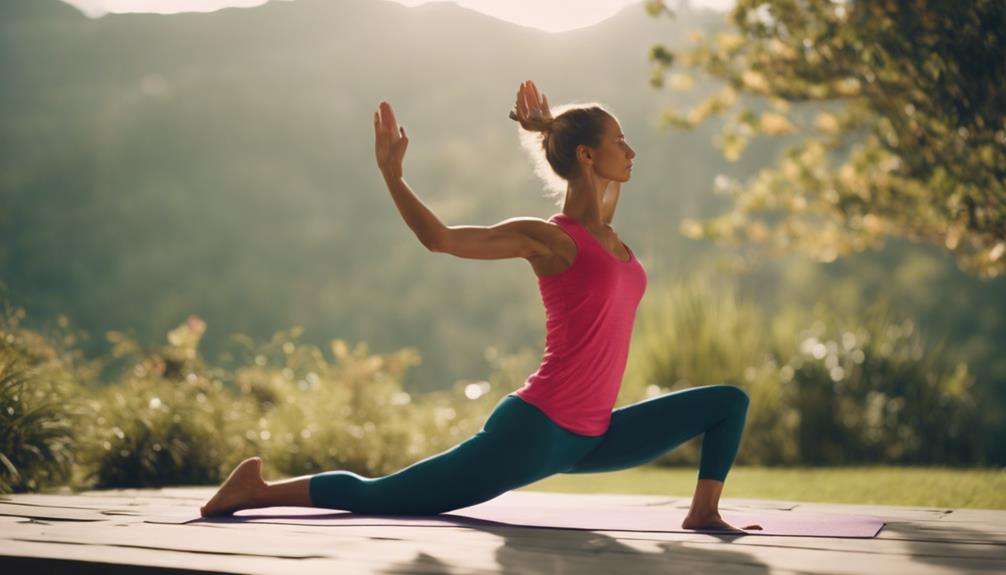As you embark on the journey of enhancing your flexibility and overall wellness, consider these 10 best practices as guiding stars in the vast sky of fitness.
Each practice is like a unique puzzle piece, fitting perfectly to create a complete picture of a healthy, agile body.
By following these expert-backed tips, you can unlock the door to a world of improved mobility and physical well-being.
So, are you ready to explore the pathway to a more flexible and balanced you?
Key Takeaways
- Engage muscles in active flexibility exercises to prevent injuries and enhance joint mobility effectively.
- Prioritize safety and avoid pushing through pain to maintain flexibility and well-being.
- Set measurable goals, track progress, and tailor exercises for optimal flexibility gains.
- Incorporate rest days, proper recovery, stress management, and well-being practices into your flexibility training routine.
Active Flexibility Exercises
Engage your muscles in active flexibility exercises to enhance joint mobility and prevent injuries effectively. Active flexibility exercises involve stretching while actively engaging muscles to move joints through their full range of motion. By incorporating these exercises into your routine, you can improve flexibility and strengthen the muscles around your joints, leading to enhanced joint stability.
Examples of active flexibility exercises include leg swings, arm circles, dynamic lunges, and controlled leg lifts. These exercises not only increase flexibility but also promote functional movement patterns and dynamic performance.
Active flexibility training can also improve muscle activation, coordination, and neuromuscular control, enhancing overall movement quality. By preparing your body for physical activities and sports, active flexibility exercises increase muscle elasticity and responsiveness, reducing the risk of injuries.
Make sure to include a variety of active flexibility exercises in your fitness regimen to reap the benefits of improved flexibility, muscle strength, and joint mobility.
Focus on Proper Form
To optimize the benefits of your flexibility training regimen, ensure that you maintain proper form throughout your stretches to prevent injuries and maximize flexibility gains. Correct alignment and posture play a crucial role in ensuring the effectiveness of each stretch by engaging the targeted muscles properly and reducing the strain on joints.
Here are some essential tips to focus on proper form during flexibility training:
- Alignment: Pay attention to the alignment of your body during each stretch to avoid unnecessary stress on joints and muscles.
- Posture: Maintain good posture while stretching to enhance muscle engagement and prevent compensatory movements that can lead to injuries.
- Engagement: Focus on engaging the specific muscles targeted by the stretch to maximize flexibility gains and avoid overloading joints.
- Breathing: Incorporate proper breathing techniques to help relax the muscles and deepen the stretch without compromising form.
Avoid Pushing Through Pain

When engaging in flexibility training, it's crucial to listen to your body's signals and avoid pushing through any pain you may experience. Pain during stretching serves as a warning sign that you should stop immediately to prevent injury. Pushing through this pain can lead to muscle strains, tears, and long-term damage, hindering your progress and overall wellness.
It's important to differentiate between discomfort, which is a normal part of stretching and can indicate progress, and harmful pain that signals potential harm to your muscles. Ignoring these pain signals can result in decreased flexibility, limited range of motion, and impaired performance.
To prevent such issues, prioritize safety and proper technique during your flexibility training sessions. Remember that a static stretch should cause mild discomfort at most, and muscle soreness the next day is normal, but sharp or intense pain should never be pushed through to ensure your well-being and progress.
Goal Setting and Relevant Drills
Setting specific, measurable goals plays a crucial role in advancing your flexibility training journey. When setting goals, it's essential to align them with your desired outcomes and tailor exercises to focus on specific movements. Vague objectives like 'get more flexible' can hinder progress, so breaking down targets into achievable milestones is key.
Consistent self-evaluation of joint range of motion helps identify areas that need improvement and allows for a more focused approach to training. Tracking your progress through workout journals or progress pictures can provide valuable insights into the effectiveness of your training methods.
Incorporate Rest Days

After focusing on goal setting and relevant drills in your flexibility training routine, it's crucial to prioritize incorporating rest days for optimal muscle recovery and growth.
Rest days are essential as they allow your muscles to repair and grow stronger after stretching sessions. It's important to avoid overtraining by not stretching the same muscle groups on consecutive days, as this can lead to overuse injuries.
Beginners should aim for 2-3 days of flexibility training per week to ensure adequate recovery time. Muscle recovery typically takes 24-48 hours, underscoring the significance of incorporating rest days in between training sessions.
For advanced practitioners, alternating between upper and lower body flexibility training days can help optimize recovery and enhance progress. Remember, rest days aren't a sign of weakness but a strategic approach to ensure your body can adapt and benefit from the flexibility training you engage in.
Prioritize rest alongside your training to achieve long-term flexibility gains.
Proper Nutrition for Flexibility
Proper nutrition is a fundamental component in enhancing flexibility by providing essential nutrients for muscle function and repair. To optimize your flexibility through nutrition, consider the following:
- Adequate Protein Intake: Protein is essential for maintaining muscle health and supporting the recovery process post-flexibility training. Include lean sources of protein such as chicken, fish, beans, and nuts in your diet.
- Fruits and Vegetables: Consuming a variety of fruits and vegetables rich in vitamins and minerals can help reduce inflammation and support overall joint health, enhancing your flexibility.
- Hydration: Staying hydrated is crucial for maintaining flexibility. Water lubricates joints and muscles, aiding in movement and preventing stiffness. Aim to drink an adequate amount of water throughout the day.
- Healthy Fats: Incorporating healthy fats like omega-3 fatty acids can help reduce inflammation and promote joint flexibility and mobility, further supporting your overall flexibility goals.
Hydration for Flexibility

Staying consistently hydrated plays a pivotal role in optimizing your flexibility performance and overall muscle function. Proper hydration supports optimal muscle function during flexibility training by ensuring adequate joint lubrication, which is essential for smooth movement and preventing stiffness.
Dehydration can lead to decreased joint lubrication and flexibility, ultimately affecting your performance during training sessions. It's crucial to maintain adequate hydration levels to prevent muscle cramps and stiffness while stretching, as water helps maintain elasticity in connective tissues, a key component for flexibility.
Remember to hydrate before, during, and after flexibility exercises to maximize results and prevent injuries. By incorporating proper hydration practices into your flexibility training routine, you can enhance your overall performance, improve joint mobility, and reduce the risk of discomfort or limitations in your range of motion.
Managing Stress Levels
To effectively manage stress levels, incorporating stress management techniques such as meditation, deep breathing, and relaxation exercises is essential. These practices have been shown to lower stress levels, reduce inflammation, and improve overall heart health.
Stress Management Techniques
Prioritizing stress management through techniques like meditation and deep breathing is crucial for maintaining a healthy heart and overall well-being.
When it comes to managing stress levels effectively, consider the following:
- Meditation: Engaging in daily meditation practices can help calm the mind and reduce stress levels significantly.
- Deep Breathing: Practicing deep breathing exercises can promote relaxation and alleviate feelings of anxiety and stress.
- Regular Exercise: Incorporating flexibility exercises and other forms of physical activity into your routine can lower stress levels and improve heart health.
- Healthy Diet: Eating a balanced diet rich in nutrients can support your body in combating stress and reducing the risk of heart disease.
Relaxation Exercises for Stress
Incorporating relaxation exercises into your daily routine can effectively lower stress levels and improve overall well-being. Techniques such as deep breathing, meditation, and progressive muscle relaxation have been shown to reduce anxiety and enhance mood. Research indicates that regular practice of these relaxation exercises not only helps in stress reduction but also leads to lower blood pressure, better immune function, and improved sleep quality.
Mind-body practices like yoga and tai chi are also beneficial for promoting relaxation and reducing stress. By integrating these relaxation exercises into your daily habits, you can better cope with stress, increase resilience, and maintain mental clarity, contributing to your overall well-being and quality of life.
Mindfulness Practices for Stress
Mindfulness practices, such as meditation and deep breathing, are highly effective in reducing stress levels and promoting overall well-being. Incorporating these practices into your daily routine can significantly impact your stress management. Here's how mindfulness practices can help you:
- Reduce Stress Levels: Mindfulness activities have been shown to lower cortisol levels, the stress hormone, leading to a calmer state of mind.
- Enhance Emotional Regulation: Mindfulness-based stress reduction techniques can improve your ability to regulate emotions and build resilience against stressors.
- Improve Focus and Attention: Engaging in mindfulness practices can enhance your focus and attention, aiding in better stress management and mental clarity.
- Cope with Stressors: By integrating mindfulness into your life, you can better cope with stressors and improve your overall mental health outcomes.
Tracking Progress
To effectively track your progress in flexibility training, utilizing goal setting methods, monitoring tools, and apps can provide valuable insights into your journey.
Goal Setting Methods
Setting clear and measurable goals is essential for effectively tracking progress in flexibility training. When it comes to goal setting methods, consider the following:
- Be Specific: Define clear objectives like touching your toes without bending your knees.
- Use Measurable Metrics: Track improvements in joint flexibility using tools like goniometers.
- Regular Self-Evaluation: Reflect on your progress weekly to identify areas needing focus.
- Set Realistic Timelines: Noticeable progress should typically occur within 4-8 weeks of consistent training.
Monitoring Tools and Apps
Various monitoring tools and apps play a crucial role in tracking progress in flexibility training, offering real-time data and visual representations to enhance motivation and optimize routines.
Apps like MyFitnessPal, Fitbit, and Strava enable users to log workouts and monitor performance metrics related to flexibility. Additionally, fitness trackers and smartwatches provide immediate feedback on heart rate, steps taken, and activity levels during flexibility training sessions.
These progress tracking features allow individuals to set goals, track achievements, and observe improvements in flexibility over time. Some apps even offer visual progress charts and graphs to illustrate changes in flexibility levels and range of motion across various muscle groups.
Celebrating Small Wins
As you reflect on your progress in flexibility training, recognizing and celebrating small wins can significantly enhance your motivation and commitment to your wellness goals. Tracking progress in flexibility training involves monitoring changes in joint range of motion, muscle flexibility, and overall performance.
Here are key points to consider:
- Small wins can include improved posture, increased ease in daily movements, and reduced muscle tightness.
- Documenting progress through photos, measurements, or flexibility tests provides tangible evidence of improvements.
- Celebrating small wins boosts motivation, reinforces consistency, and highlights the benefits of regular flexibility training.
- Recognizing incremental advancements in flexibility encourages continued effort and supports long-term commitment to wellness goals.
Adaptability and Adjustment
To successfully navigate through plateaus in flexibility training, incorporating adaptability and making adjustments to your routine is crucial for continued progress. If you find that your flexibility training has stagnated for over a month, it may be time to consider program adjustments.
Experimenting with different approaches based on scientific hypotheses can help overcome these plateaus. Incorporating active flexibility exercises alongside passive stretching can also enhance your results. Additionally, increasing rest days may be necessary to allow your body to recover and adapt to the demands of your training.
Seeking feedback from a flexibility coach can provide valuable insights and tailored routines to help you push past training plateaus. By staying adaptable and open to making adjustments in your flexibility training program, you can continue to make progress and reach new levels of flexibility and wellness.
Frequently Asked Questions
What Is the Best Training Method for Flexibility?
For optimal flexibility, combine dynamic stretching, PNF techniques, yoga poses, and ballet stretches. Engage muscles actively and deepen stretches using props like foam rollers. Tailor your program to individual needs for maximum gains in flexibility and wellness.
What Are the Guidelines for Flexibility Training?
To improve flexibility, aim for 2-3 weekly sessions. Stretch major muscle groups for 10-30 seconds each. Consistent daily stretching yields long-term gains. Older adults may benefit from 30-60 second holds. Vary exercises for comprehensive flexibility training.
What Are 5 Activities That Improve Flexibility?
To improve flexibility, engage in yoga for muscle stretching, Pilates for controlled movements, dance for muscle elongation, dynamic stretching for range of motion, and Tai Chi for balance. Incorporate these activities into your routine for enhanced flexibility.
What Are the ACE Recommendations for Flexibility Training?
Stretching techniques improve your flexibility and mobility. ACE recommends incorporating daily stretching focusing on major muscle-tendon units. Holding stretches for 10-30 seconds benefits most adults, while older individuals may benefit from 30-60 seconds. Adjust as needed.
Conclusion
In conclusion, remember that Rome wasn't built in a day. Consistent dedication to flexibility training, along with proper form and listening to your body, is key to achieving long-term benefits.
By incorporating these best practices into your routine and staying committed, you can improve joint range of motion, prevent injuries, and enhance your overall performance.
Keep pushing yourself, but also remember to give your body the rest and recovery it needs to thrive. Stay flexible, stay strong, and enjoy the journey to wellness.






